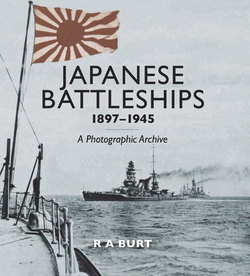Читать книгу Japanese Battleships, 1897?1945 - R. A. Burt - Страница 8
ОглавлениеDisplacement: 12,450 tons normal load
Dimensions: Length: 406ft 6in oa; Beam: 73ft; Draught: 27ft mean
Armament: 4 × 12in 40cal; 10 × 6in; 20 × 47mm QF; 2 × 47mm Hotchkiss; TT: 5 × 18in
Armour: Main belt: 18in–14in (Harvey); Bulkheads: 14in–12in; Barbettes: 14in–9in–4in; Turrets: 6in–3in; Casemates: 6in–2in; Decks: 2½in; Conning tower: 14in
Machinery: Two sets three-cylinder, triple-expansion engines driving two screws, ten cylindrical, single-ended boilers
Designed SHP: 10,200 normal; 14,100 forced for 18.5 knots
Fuel: 700–1,200 tons coal
Complement: 600
Laid down: 1894, Thames Ironworks, Blackwall
Launched: 31 March 1896
Completed: August 1897
Fate: Scrapped, 1948
Laid down: 1894, Armstrong’s, Newcastle
Launched: 28 February 1896
Completed: September 1897
Fate: Struck Russian mine and sank later while in tow (15 May 1904)
Fuji at the Coronation Fleet Review at Spithead August 1902
After the Sino-Japanese War (1894–95) the Japanese government sanctioned sufficient funds to provide their fleet with modern battleships and, looking to Great Britain for the latest technology, placed orders at Thames Ironworks and Armstrong’s for one ship each. Laid down in 1894, they benefited from the British experience of building the Royal Sovereign-class (1893) and improvements were worked in. As completed, Fuji and Yashima were very like the Royal Sovereigns except that the funnels were set longitudinally instead of athwartships and the main guns were given protective turrets. Yashima was sunk in 1904, but Fuji had a long and varied career. Re-rated as a coastal defence ship in 1910, she was then used as a gunnery training ship from that date on. Finally she was disarmed and partially stripped for use as a transport and stores ship in 1922; a role in which she continued until as late as 1945.
Yashima May 1897
Fuji and Yashima had been designed and constructed to completely outclass any warship in the Chinese Navy, a navy that had always been a constant threat to the Japanese fleet since the battle of the Yalu in 1894. Constructed with a close eye on British designs, they were completed during 1897 and turned out to be a complete success for the period in which they were built. Not only very superior to anything in the Chinese Navy, they equalled major ships in the Russian Navy and were admired within the Royal Navy as being well-balanced designs on the given displacement. Both ships were frequently in action during the Russo-Japanese War, with Yashima being finally mined and sunk during that campaign. She is shown here in the River Tyne in her final stages of fitting-out having been just moved out of Armstrong’s Yard and about to undergo a lengthy series of sea trials.
Yashima leaving the Tyne as completed September 1897
These were Japan’s first real contemporary battleships and as such brought the country into the pre-dreadnought era. In service they were handy with good sea-keeping qualities. The main armament could be loaded in all positions, but other than the usual end-on method, loading was very slow in practice. Yashima could easily be identified from her sister by different ventilation cowls and steam pipes on the funnels. During the Russo-Japanese War, Yashima struck a mine on 15 May 1904 and foundered on her way home, just off Sasebo.
